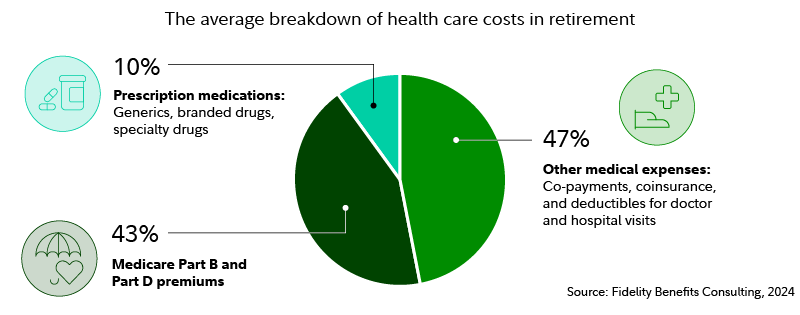For most Americans, health care is expected to be one of the largest expenses in retirement. However, unlike your parents' generation, you won't likely have access to employer or union-sponsored retiree health benefits. Health care costs will likely consume a larger portion of your retirement budget—and you need to plan for that.
There are a number of drivers behind this mounting retirement health care cost challenge. In general, people are living longer, health care inflation continues to outpace the rate of general inflation, and the average retirement age is 62 for most Americans—3 years before you are eligible to enroll in Medicare.
"Health care is creating a 'retirement cost gap' for many pre-retirees," says Steve Feinschreiber, senior vice president of the Financial Solutions Group at Fidelity. "Many people assume Medicare will cover all your health care costs in retirement, but it doesn't, so you should carefully weigh all options."
How much is needed for health care costs in retirement?
On average, according to the 2025 Fidelity Retiree Health Care Cost Estimate, a 65-year-old individual may need $172,500 in after-tax savings to cover health care expenses in retirement.
This amount is up nearly 4% from 2024.
The amount you’ll need will depend on when and where you retire, how healthy you are, and how long you live. It also depends on which accounts you use to pay for health care—e.g., 401(k), HSA, IRA, or taxable accounts; your tax rates in retirement (see chart below); and potentially even your gross income.2
Tip: If you're still working and your employer offers an HSA-eligible health plan, consider enrolling and contributing to a health savings account (HSA). An HSA can help you save tax-efficiently for health care costs in retirement. You can save pretax dollars (and possibly collect employer contributions), which have the potential to grow and be withdrawn tax-free for federal and state tax purposes, if used for qualified medical expenses.3
To learn more, read Viewpoints on Fidelity.com: 5 ways HSAs can fortify your retirement
Pre- and early retirees: Make the most of your time to prepare
As retirement approaches, you will have several big decisions to make, including when to stop working, when to take Social Security, how to pay for health care, and how to generate cash flow from your retirement assets. These decisions are interconnected and could make a difference in your living costs and lifestyle in retirement—and when you can retire.
Approximately one-third of "early retirees" who claim Social Security at age 62 do so to help pay for health care expenses until they are eligible for Medicare coverage at age 654. However, if you can postpone retirement or save enough to cover health care costs until 65, then you may be able to defer your Social Security benefits. Generally, the longer you can wait (until age 70) to take Social Security benefits, the more you can collect, assuming you live a long life.
To learn more, read Viewpoints on Fidelity.com: Should you take Social Security at 62?
Most people probably don't have access to employer-sponsored pre-65 retiree medical coverage, so if you retire prior to age 65, you may need to find coverage until you are eligible for Medicare. The table below provides options that may be available to you.
Retiring before 65? Explore health insurance options and estimate potential costs before you’re Medicare-eligible.
| COBRA continuation | Spouse's health plan | Public marketplace | Private insurance | |
|---|---|---|---|---|
| Target audience | Former employees | Eligible spouses/partners of covered employees | Anyone | Anyone |
| Estimated cost | $$–$$$ | $–$$ | $$–$$$ | $$–$$$ |
| Considerations | Few employers subsidize COBRA; you may pay the full cost of the coverage. | Not all employers offer this benefit; special rules or surcharges may apply. | You may qualify for federal assistance based on your income. | Your former employer might provide a reimbursement account that can help you afford the cost of these plans. |
Good to know: While you can’t use an HSA to cover health care premiums, you can use it to cover COBRA premiums while you’re unemployed.
Turning 65 and retiring: Consider Medicare and other options
When you get close to age 65, spend some time reviewing and considering all your Medicare options. When you do become eligible at age 65, you'll want to remember to sign up during your 7-month initial enrollment period that begins 3 months before the month you turn 65.
There's a lot to learn about the world of Medicare. You'll need to know about Medicare Parts A, B, and D, as well as Medicare Advantage and "Medigap" supplemental insurance plans.
In summary:
- Part A covers hospital costs after you meet a deductible.
- Part B is optional coverage for medical expenses and requires an annual premium. If you didn't get Part B when you were first eligible, your monthly premium may go up 10% for each 12-month period you could've had Part B, but didn't sign up. In most cases, you'll have to pay a penalty each time you pay your premiums, for as long as you have Part B. The penalty increases the longer you go without Part B coverage.
- Part D is for prescription drug coverage.
- Medicare Advantage plans are all-in-one managed care plans that provide the services covered under Part A and Part B of Medicare and may also cover other services that are not covered under Parts A and B, including Part D prescription drug coverage.
- Supplemental policies, referred to as Medigap policies, are offered by private insurance companies to supplement expenses that Medicare Parts A and B do not typically cover.
Tip: You may be better off paying a higher premium but not having to pay out-of-pocket at office visits. Look at the cost of annual premiums and co-pays at different levels of supplemental insurance. Compare costs. Then, factor in the number of visits and co-pay/co-insurance per visit that you anticipate for the next year.
Once you select a Medicare plan, it doesn't have to be permanent. You can switch Medicare plans as you age and as your situation changes. (However, this does not apply to Medigap policies.) Generally, it makes sense to enroll in Medicare Parts A, B, and D when you are first eligible because the late enrollment penalties for doing so later are steep. For example, you may owe a late enrollment penalty if you go without Part D or other creditable prescription drug coverage for any period of 63 consecutive days after your initial enrollment period.
To learn more about Medicare with Fidelity's educational tools and resources, visit Fidelity Medicare Services®.
To explore your options for coverage, make decisions about starting Medicare, and know what to do if you continue to work past age 65, visit Finding health coverage in retirement.
Turning 65 and still gainfully employed (or your spouse/partner is)
If you're still working when you're 65 and get health insurance through your employer or your spouse's employer, you'll have the opportunity to enroll in Medicare when you leave your employer plan through a Special Enrollment Period.
In addition, if your spouse or partner continues to work, they may be able to cover you through their health plan. Talk to your HR department to help you evaluate all your options, costs, and any restrictions. The rules of Medicare are complicated, so to get started, consider the following questions:
- Which option provides the best coverage for your health needs? Medicare or the plan offered by your (or potentially your spouse's) employer?
- Your employer is required to offer you coverage, but is that your best option?
- Is it more expensive to stay in your employer plan or join Medicare?
- Can your spouse or partner remain in your employer's plan if you decide to leave?
Tip: Remember, one of the key goals at this stage is to avoid any gap in coverage.
To learn more, read Viewpoints on Fidelity.com: 6 key Medicare questions and Medigap 101: What you need to know
Health care in retirement: Costs can come later
As you plan for health care expenses throughout your retirement, it could be worthwhile to understand how paying for potential future costs fits into your overall retirement income planning efforts because health care utilization tends to increase as we age.
"Although health care costs continue to rise, there are financial planning steps that you can take today to help prevent health care costs from eating into your retirement lifestyle," Feinschreiber advises. "For example, if you're age 50 or older, you may be able to make up for a savings shortfall with additional catch-up contributions to your 401(k) or IRA. In addition, if you are age 55 or older, you can make an additional $1,000 catch-up contribution annually to your health savings account."
To learn more, read Viewpoints on Fidelity.com: What will my savings cover in retirement?



